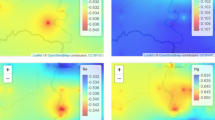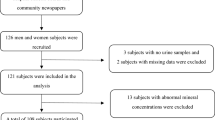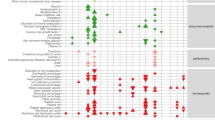Abstract
Background
Trace elements comprise both nutritionally essential and non-essential, and their presence in organisms plays important role in human health.
Objective
The aim of this study was to evaluate the levels of trace elements, together with cellular and molecular biomarkers, in adolescents from Tierrabomba Island, a Caribbean community located near an industrial area, comparing them with a group living in San Onofre, a reference community.
Methods
Hair and blood samples were obtained from 238 individuals aged 11–18 years old, 131 from Tierrabomba Island and 107 from San Onofre. Trace elements were quantified in hair using ICP-MS. The hematological evaluation was done by peripheral blood smears, and gene expression analysis was carried out through RT-PCR.
Results
Thirteen elements were analyzed; eight showed significant differences between sites. In Tierrabomba, arsenic (As) and tungsten (W) registered mean values greater than in San Onofre. In contrast, in the reference site, average values for boron (B), cobalt (Co), zinc (Zn), yttrium (Y), tin (Sn), and barium (Ba) were greater. The peripheral blood film showed differences between populations. Mean lymphocyte percentage was higher in the Island, while eosinophil and monocyte percentages displayed greater means in San Onofre. Some correlations between trace elements and hematological parameters were found, mainly with platelets in Tierrabomba. This trend remained even when partial correlation coefficients were adjusted for age. Levels of gene expression of metallothionein 1X (MT1X) and superoxide dismutase (SOD) registered significant differences between sites, being greater in Tierrabomba. Negative correlations between SOD and As were observed in both sampling sites. Discriminant analysis suggested sampling locations could be differentiated by Zn, Mo, Ba, and MT1X levels.
Significance
Trace elements and the relative gene expression associated with metal exposure are critical exposure biomarkers for coastal communities.
This is a preview of subscription content, access via your institution
Access options
Subscribe to this journal
Receive 6 print issues and online access
$259.00 per year
only $43.17 per issue
Buy this article
- Purchase on Springer Link
- Instant access to full article PDF
Prices may be subject to local taxes which are calculated during checkout




Similar content being viewed by others
References
Ballesteros MTL, Serrano IN, Álvarez SI. Reference levels of trace elements in hair samples from children and adolescents in Madrid, Spain. J Trace Elem Med Biol. 2017;43:113–20.
Kibria G. Trace metals/heavy metals and its impact on environment, biodiversity and human health—a short review. 2016;5 https://doi.org/10.13140/RG.2.1.3102.2568.
Prashanth L, Kattapagari KK, Chitturi RT, Baddam VRR, Prasad LK. A review on role of essential trace elements in health and disease. J NTR Univ Health Sci. 2015;4:75.
Mehri A, Marjan RF. Trace elements in human nutrition: a review. Int J Med Invest. 2013;2:115–28.
Jin J, Mulesa L, Carrilero Rouillet M. Trace elements in parenteral nutrition: considerations for the prescribing clinician. Nutrients. 2017;9:440.
Bhattacharya PT, Misra SR, Hussain M. Nutritional aspects of essential trace elements in oral health and disease: an extensive review. Scientifica. 2016;2016:5464373.
Priebatsch KM, Kvansakul M, Poon IK, Hulett MD. Functional regulation of the plasma protein histidine-rich glycoprotein by Zn2+ in settings of tissue injury. Biomolecules. 2017;7:22.
Antoniadis V, Shaheen SM, Levizou E, Shahid M, Niazi NK, Vithanage M, et al. A critical prospective analysis of the potential toxicity of trace element regulation limits in soils worldwide: are they protective concerning health risk assessment?—a review. Environ Int. 2019;127:819–47.
Skalnaya MG, Skalny AV. Essential trace elements in human health: a physician’s view. Tomsk: Publishing House of Tomsk State University; 2018.
Iyengar GV, Rapp A. Human placenta as a ‘dual’ biomarker for monitoring fetal and maternal environment with special reference to potentially toxic trace elements. Part 2: essential minor, trace and other (non-essential) elements in human placenta. Sci Total Environ. 2001;280:207–19.
Tchounwou PB, Yedjou CG, Patlolla AK, Sutton DJ. Heavy metal toxicity and the environment. In: Lunch A, editor. Molecular, clinical and environmental toxicology, volume 3: environmental toxicology. Basel: Springer; 2012, pp. 133–64.
Velickova N. Environmental impact of heavy metals on the blood cells in professionally exposed workers. J Environ Prot Ecol. 2017;18:363–74.
Hegazy AA, Zaher MM, Abd el-hafez MA, Morsy AA, Saleh RA. Relation between anemia and blood levels of lead, copper, zinc and iron among children. BMC Res Notes. 2010;3:133.
Korashy HM, Attafi IM, Famulski KS, Bakheet SA, Hafez MM, Alsaad AMS, et al. Gene expression profiling to identify the toxicities and potentially relevant human disease outcomes associated with environmental heavy metal exposure. Environ Pollut. 2017;221:64–74.
Manjarres-Suarez A, Olivero-Verbel J. Hematological parameters and hair mercury levels in adolescents from the Colombian Caribbean. Environ Sci Pollut Res. 2020;27:14216–27.
Adewoyin AS, Nwogoh B. Peripheral blood film—a review. Ann Ib Postgrad Med. 2014;12:71–79.
Frazzoli C, Bocca B, Mantovani A. The one health perspective in trace elements biomonitoring. J Toxicol Env Heal B. 2015;18:344–70.
Al Bakheet SA, Attafi IM, Maayah ZH, Abd-Allah AR, Asiri YA, Korashy HM. Effect of long-term human exposure to environmental heavy metals on the expression of detoxification and DNA repair genes. Environ Pollut. 2013;181:226–32.
Monastero RN, Vacchi-Suzzi C, Marsit C, Demple B, Meliker JR. Expression of genes involved in stress, toxicity, inflammation, and autoimmunity in relation to cadmium, mercury, and lead in human blood: a pilot study. Toxics. 2018;6:35.
Sabath E, Robles-Osorio ML. Renal health and the environment: heavy metal nephrotoxicity. Nefrolía (Engl Ed). 2012;32:279–86.
McNeill RV, Mason AS, Hodson ME, Catto JW, Southgate J. Specificity of the metallothionein-1 response by cadmium-exposed normal human urothelial cells. Int J Mol Sci. 2019;20:1344.
Al-Wahaibi A, Zeka A. Health impacts from living near a major industrial park in Oman. BMC Public Health. 2015;15:524.
Eom SY, Choi J, Bae S, Lim JA, Kim GB, Yu SD, et al. Health effects of environmental pollution in population living near industrial complex areas in Korea. Environ Health Toxicol. 2018.33:e2018004.
Xie W, Peng C, Wang H, Chen W. Health risk assessment of trace metals in various environmental media, crops and human hair from a mining affected area. Int J Environ Res Public Health. 2017;14:1595.
Kanu I, Achi OK. Industrial effluents and their impact on water quality of receiving rivers in Nigeria. J Appl Tech Environ Sanit. 2011;1:75–86.
Montealegre CC, Dáger GM. Sedimentation in the Cartagena Bay, a socioeconomic impact. Dictamen Libre. 2015;16:11–20.
Johnson-Restrepo B, Olivero-Verbel J, Lu S, Guette-Fernández J, Baldiris-Avila R, O’Byrne-Hoyos I, et al. Polycyclic aromatic hydrocarbons and their hydroxylated metabolites in fish bile and sediments from coastal waters of Colombia. Environ Pollut. 2008;151:452–9.
Olivero-Verbel J, Johnson-Restrepo B, Baldiris-Avila R, Güette-Fernández J, Magallanes-Carreazo E, Vanegas-Ramírez L, et al. Human and crab exposure to mercury in the Caribbean coastal shoreline of Colombia: impact from an abandoned chlor-alkali plant. Environ Int. 2008;34:476–82.
Jaramillo-Colorado BE, Arroyo-Salgado B, Ruiz-Garcés LC. Organochlorine pesticides and parasites in Mugil incilis collected in Cartagena Bay, Colombia. Environ Sci Pollut Res. 2015;22:17475–85.
Caballero-Gallardo K, Alcala-Orozco M, Barraza-Quiroz D, De la Rosa J, Olivero-Verbel J. Environmental risks associated with trace elements in sediments from Cartagena Bay, an industrialized site at the Caribbean. Chemosphere. 2020;242:125173.
Alvarez-Ortega N, Caballero-Gallardo K, Olivero-Verbel J. Toxicological effects in children exposed to lead: a cross-sectional study at the Colombian Caribbean coast. Environ Int. 2019;130:104809.
Dhakar S, Diwaker P, Gogoi P, Singh B, Kumar S. Platelet count estimation using unstained and stained peripheral blood smears: a comparative study. J Clin Diagn Res. 2018;12:EC14–EC16.
Kuras R, Reszka E, Wieczorek E, Jablonska E, Gromadzinska J, Malachowska B, et al. Biomarkers of selenium status and antioxidant effect in workers occupationally exposed to mercury. J Trace Elem Med Biol. 2018;49:43–50.
Drobyshev EJ, Solovyev ND, Ivanenko NB, Kombarova MY, Ganeev AA. Trace element biomonitoring in hair of school children from a polluted area by sector field inductively coupled plasma mass spectrometry. J Trace Elem Med Biol. 2017;39:14–20.
Bansal SL, Asthana S. Biologically essential and non-essential elements causing toxicity in environment. J Environ Anal Toxicol. 2018;8:557.
Vimercati L, Gatti MF, Gagliardi T, Cuccaro F, De Maria L, Caputi A, et al. Environmental exposure to arsenic and chromium in an industrial area. Environ Sci Pollut Res. 2017;24:11528–35.
Dongarrà G, Varrica D, Tamburo E, D’Andrea D. Trace elements in scalp hair of children living in differing environmental contexts in Sicily (Italy). Environ Toxicol Pharmacol. 2012;34:160–9.
Johansson L. Trace element levels in scalp hair from adolescents in Río Negro, Argentina: Link to Environmental and Dietary Factors [Dissertation]. 2011.
Carneiro MFH, Moresco MB, Chagas GR, de Oliveira Souza VC, Rhoden CR, Barbosa F. Assessment of trace elements in scalp hair of a young urban population in Brazil. Biol Trace Elem Res. 2011;143:815–24.
Krejpcio Z, Olejnik D, Wójciak RW, Gawecki J. Comparison of trace elements in the hair of children inhabiting areas of different environmental pollution types. Pol J Environ Stud. 1999;8:227–30.
Barbieri FL, Cournil A, Sarkis JES, Bénéfice E, Gardon J. Hair trace elements concentration to describe polymetallic mining waste exposure in Bolivian Altiplano. Biol Trace Elem Res. 2011;139:10–23.
Choudhury TR, Ali M, Rahin SA, Ali MP. Trace elements in the hair of normal and chronic arsenism people. Glob Adv Res J Environ Sci Toxicol. 2013;2:163–73.
Evrenoglou L, Partsinevelou AS, Nicolopoulou-Stamati P. Correlation between concentrations of heavy metals in children’s scalp hair and the environment. A case study from Kifissos River in Attica. Greece Global Nest J. 2017;19:592–600.
Mohankumar K, Hariharan V, Rao NP. Heavy metal contamination in groundwater around industrial estate vs residential areas in Coimbatore, India. J Clin Diagn Res. 2016;10:BC05.
ATSDR. Agency for Toxic Substances and Disease Registry. Chapter 1. Public health statement. In: Toxicological profile for tungsten. Atlanta, GA, USA: US Department of Health and Human Services; 2005, pp. 1–10.
Nouioui MA, Araoud M, Milliand ML, Bessueille-Barbier F, Amira D, Ayouni-Derouiche L, et al. Evaluation of the status and the relationship between essential and toxic elements in the hair of occupationally exposed workers. Environ Monit Assess. 2018;190:1–28.
Woshner VM, O’Hara TM, Bratton GR, Suydam RS, Beasley VR. Concentrations and interactions of selected essential and non-essential elements in bowhead and beluga whales of Arctic Alaska. J Wildl Dis. 2001;37:693–710.
Alonso ML, Montaña FP, Miranda M, Castillo C, Hernández J, Benedito JL. Interactions between toxic (As, Cd, Hg and Pb) and nutritional essential (Ca, Co, Cr, Cu, Fe, Mn, Mo, Ni, Se, Zn) elements in the tissues of cattle from NW Spain. Biometals. 2004;17:389–97.
Zhu Y, Cao X, Tao G, Xie W, Hu Z, Xu D. The lymph index: a potential hematological parameter for viral infection. Int J Infect Dis. 2013;17:e490–e493.
Kovalszki A, Weller PF. Eosinophilia. Prim Care 2016;43:607–17.
Atto V, Bléyéré NM, Konan BA, Amonkan KA, Kouakou KL, Bouafou KGM, et al. Haematological profile of adolescents in Abidjan (Côte d’Ivoire). Int J Biosci. 2012;2:1–12.
ATSDR. Agency for Toxic Substances and Disease Registry. Toxicological profile for cadmium. Atlanta, GA, USA: The United States Public Health Service, Agency for Toxic Substances and Disease Registry; 2012, pp 1–487.
Andjelkovic M, Buha Djordjevic A, Antonijevic E, Antonijevic B, Stanic M, Kotur-Stevuljevic J, et al. Toxic effect of acute cadmium and lead exposure in rat blood, liver, and kidney. Int J Environ Res Public Health. 2019;16:274.
Yılmaz H, Keten A, Karacaoğlu E, Tutkun E, Akçan R. Analysis of the hematological and biochemical parameters related to lead intoxication. J Forensic Leg Med. 2012;19:452–4.
Barman T, Kalahasthi R, Rajmohan HR. Effects of lead exposure on the status of platelet indices in workers involved in a lead-acid battery manufacturing plant. J Expo Sci Environ Epidemiol. 2014;24:629–33.
Abdel-Shafy HI, Mansour MS. A review on polycyclic aromatic hydrocarbons: source, environmental impact, effect on human health and remediation. Egypt J Pet. 2016;25:107–23.
Falnoga I, Pevec AZ, Šlejkovec Z, Žnidarič MT, Zajc I, Mlakar SJ, et al. Arsenic trioxide (ATO) influences the gene expression of metallothioneins in human glioblastoma cells. Biol Trace Elem Res. 2012;149:331–9.
Chu A, Foster M, Ward S, Zaman K, Hancock D, Petocz P, et al. Zinc-induced upregulation of metallothionein (MT)-2A is predicted by gene expression of zinc transporters in healthy adults. Genes Nutr. 2015;10:44.
González M, Reyes-Jara A, Suazo M, Jo WJ, Vulpe C. Expression of copper-related genes in response to copper load. Am J Clin Nutr. 2008;88:830S–834S.
Macirella R, Guardia A, Pellegrino D, Bernabò I, Tronci V, Ebbesson L, et al. Effects of two sublethal concentrations of mercury chloride on the morphology and metallothionein activity in the liver of zebrafish (Danio rerio). Int J Mol Sci. 2016;17:361.
Pizzino G, Bitto A, Interdonato M, Galfo F, Irrera N, Mecchio A, et al. Oxidative stress and DNA repair and detoxification gene expression in adolescents exposed to heavy metals living in the Milazzo-Valle del Mela area (Sicily, Italy). Redox Biol. 2014;2:686–93.
Smedley PL, Kinniburgh DG. Molybdenum in natural waters: a review of occurrence, distributions and controls. Appl Geochem. 2017;84:387–432.
Kravchenko J, Darrah TH, Miller RK, Lyerly HK, Vengosh A. A review of the health impacts of barium from natural and anthropogenic exposure. Environ Geochem Health. 2014;36:797–814.
Acknowledgements
The authors thank the School Community of the Tierrabomba Island (Cartagena) and Berrugas (San Onofre), as well as Dr Dager Berrio, Jaime Luna, and Maria Millan for their collaboration in this research.
Funding
This research was funded by Colciencias-University of Cartagena (Grant 110777757883, 778/2017), the National Program for Doctoral Formation (Colciencias, 727-2015), and the Program to Support Research Groups (UniCartagena, 2018–21).
Author information
Authors and Affiliations
Corresponding author
Ethics declarations
Conflict of interest
The authors declare no competing interests.
Additional information
Publisher’s note Springer Nature remains neutral with regard to jurisdictional claims in published maps and institutional affiliations.
Supplementary information
Rights and permissions
About this article
Cite this article
Manjarres-Suarez, A., de la Rosa, J., Gonzalez-Montes, A. et al. Trace elements, peripheral blood film, and gene expression status in adolescents living near an industrial area in the Colombian Caribbean Coastline. J Expo Sci Environ Epidemiol 32, 146–155 (2022). https://doi.org/10.1038/s41370-021-00340-6
Received:
Revised:
Accepted:
Published:
Issue Date:
DOI: https://doi.org/10.1038/s41370-021-00340-6



